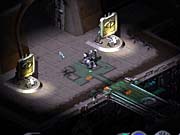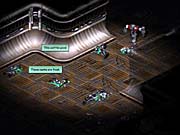While most action role-playing games, such as the extremely successful Diablo series, are set in a fantasy world, Harbinger attempts to stand apart from the crowd by taking on a sci-fi theme. Although the futuristic setting is a welcome change of pace, Harbinger falls short of the mark, with half-baked action and role-playing elements that are overly shallow and simplistic.

The game takes place on the titular space cruiser, in which a small band of outcasts hides away in a tiny corner of the ship. Harbinger is a slave ship, and most of its occupants are trapped aboard under the iron-fisted control of a being known only as "the overlord." Amidst the backdrop of a major war between the ship's primary factions, you and your band of misfits attempt to stay alive.
There are only three character classes to choose from in Harbinger: human, gladiator, and culibine. The gladiator is a cyborglike robot infused with the consciousness of a living being, while the culibine resembles Diablo's sorcerer character, though in practice, all the classes play about the same. While the different classes have special gadgets they can use--the gladiator can control remotely operated cameras and the human can drop mines of varying types, for example--these items actually don't figure prominently into the gameplay because of play-balance issues between the attack types.
All three classes have a ranged attack, and the human and gladiator have true melee attacks. When engaged in close-quarters combat, the culibine can use a spell-like ability to damage enemies in a small radius around her. However, almost all ranged attacks from enemies in Harbinger are slow projectiles that are easily dodged. You can also outrun just about all the enemies in the game. As a result, you'll find that the entire game consists of running away, firing off a couple of shots, dodging your enemies' shots, and then running some more. There is no point in putting yourself in harm's way by moving into melee range when you can avoid damage altogether by just running and shooting all the time. While you could argue that this kind of shallow gameplay is a feature of almost any other game of this kind, Harbinger lacks the fun elements that better action RPGs possess.
There are few monster types in Harbinger. In fact, for some bizarre reason, the game has about as many different types of treasure chests (in which you can find items and weapons) as it does enemies, especially if you count the same soldier carrying three or four different weapons as one unique type, and the same bug with slightly different coloring and textures as one type. Each character class has only four different attributes to choose from when it gains an experience level. Since melee combat is more or less useless, that leaves three useful attributes per character. This relative lack of traits or new skills to unlock essentially takes all the excitement out of gaining levels.
There isn't even any fun in finding new weapons and armor, because each character can use only extremely specific types of armor or weapons. Gathering money doesn't even come into play until about three-quarters of the way through the game, when the merchant finally turns over his inventory with better items. About the only thing you'll want to buy are health packs, because you can almost always find better equipment in the field.
The only depth to be found in Harbinger is the fact that different enemies are vulnerable to different types of attacks. For example, robotic opponents are weak against EMP attacks, while the buglike cimicidae are vulnerable to electricity. Once you find a weapon that can fire all four different types of attacks, you're all set for the rest of the game, and playing is just a matter of swapping different attack types into the same weapon.

Unlike Diablo, Harbinger doesn't feature randomly generated maps or any multiplayer options; it's strictly a single-player game. Although the three classes play along separate but parallel mission paths that intersect from time to time (with limited branching options), the replay value in Harbinger is extremely limited--it's unlikely that you'd want to play the game again with another class after beating the campaign once.
Graphically, Harbinger is no better than average. While it has some reasonably detailed environments, the game suffers from a lack of frames in its character animation and occasional slowdown when a lot of enemies are onscreen. There isn't a lot of music in the game aside from some background pieces to set the mood, and the sound effects are fairly basic, so even the game's production values are particularly engaging. With so many better options available, Harbinger's shallow gameplay and limited replay value make it difficult to recommend, even with its modest retail price of $30.